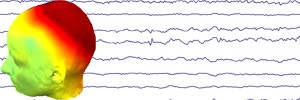Here is a brief list of some of the current projects we have going on in the lab right now:
Individual Differences in Language Comprehension
A common theme in all of our research is the investigation of individual differences in the neural mechanisms of real-time language comprehension, in both native and second language learners. A major goal in our studies is to identify how individual differences in language comprehension manifest themselves in in brain-based measures of language processing (e.g., ERPs), what factors relate to these differences in processing mechanisms, and what the practical consequences of these differences are. In particular, we are looking at numerous cognitive (e.g., working memory, executive function, cortical organization of language functions) and experiential (e.g., language proficiency and use) determinants of differences in language processing, and how these map on to language comprehension behaviors and success in foreign language learning.
Researchers: Tanner, Armstrong, Reyes, Zhang, Montrul, Van Hell
Bilingualism and Second Language Learning and Processing
Adults second language learners have a notoriously difficult time mastering a new language. One of our major goals is to understand how second language learners use and process linguistic information. That is, how do learners access words, and integrate those words into meaningful larger linguistic units, like sentences and discourses. Moreover, having more than one language in one’s repertoire introduces problems that monolinguals do not face, even if the bilingual is not equally proficient in both languages (as is often the case with adult language learners). For example, how to bilinguals manage activation of their two languages, and how does information from the two languages interact during real-time language use? To help answer these questions we use behavioral measures, like priming and self-paced reading, as well as eye tracking and ERPs.
Researchers: Green, Tanner, Montrul, Reyes, Armstrong, Zhang, Christianson, Morgan-Short
Agreement in Language Comprehension
In a series of studies, we are using ERPs and eye tracking to investigate factors impacting the processing of agreement dependencies during language comprehension. These include factors related to encoding and retrieval of agreement features, morphological realization of agreement features on targets, and attraction interference during real-time language processing. This set of studies involves monolingual English speakers, as well as second language learners and bilinguals.
Researchers: Tanner, Brehm, Armstrong, Christianson, Dempsey
Prediction in Language Comprehension
Language comprehension is an active process, and it is now well-established that comprehension involves active prediction of upcoming information. Some of our work uses ERPs and eye tracking to investigate the level of these predictions. How fine-grained do predictions become during reading? Do they involve semantic classes, specific words, specific sounds, specific letters, shapes of letters, and how does sentence context modulate the granularity of these predictions? How do learning context and lexical representations in an L2 influence how and whether language users use contextual cues to predict upcoming referents? Moreover, how does prediction play out in computer-mediated communication (e.g., text messaging), where ideograms such as emojis are sometimes used instead of words?
Researchers: Green, Christianson, Tanner, Weissman, Sun
Non-literal language comprehension and emoji processing
During normal language comprehension, we have to be able to understand both literal and non-literal expressions. The meaning of literal language expressions can be composed from the meanings of the individual words in the expression, but non-literal language — like idioms and metaphors — goes beyond what is explicitly said. In a series of experiments using ERPs and eye tracking, we are studying factors related to how we comprehend non-literal language, and how this relates to and compares with formulaic literal language processing. These studies investigate how formulaic expressions, like idioms and other collocates, are stored in the mental lexicon, how we predict words in formulaic expressions, and whether literal and non-literal formulaic sequences are accessed and predicted similarly. We are working on these issues in both native speakers and second language learners.
Moreover, sometimes verbal messages don’t just contain words, but meaningful ideograms, like emojis. We’re working on a series of ERP projects related to how language users incorporate meaning from emojis into context (e.g., sarcasm, contextual constraint).
Researchers: Bulkes, Weissman, Tanner
Information Retrieval in Native and Non-native Lexical Access
When we need to access a word during speech production or during reading, we need to activate multiple types of information associated with the word: e.g., the word’s conceptual representation and semantic meaning, the phonology of the word, as well as syntactic information about the word, including word category and in some languages grammatical gender. We are using ERPs to track the time course of how we access this lexical information during language production and language comprehension, in both native and second language learner populations. This line of research will inform models of lexical access in native and nonnatives populations. It will also inform language teaching practices as we identify how “mis-fires” within the time course of information retrieval feed into comprehension and production difficulties in non-native language use, and how different types of language training impact the time course of information retrieval.
Researchers: Shantz, Tanner, Dye, Montrul
Reference resolution in native and non-native speakers
Resolving reference is a major part of any conversation. In a series of experiments using eyetracking and ERPs, we are investigating what kinds of information can be used to resolve pronouns (e.g. he/she) and how prediction interacts with other sources of information in reference resolution. For second language learners, we are interested in the extent to which they are able to use information and strategies that are different in their native and non-native language. For example, to what extent is a speaker able to use gender on a pronoun in their second language to resolve reference if their first language does not have grammatical gender? This set of studies involves monolingual English speakers, and speakers of Mandarin Chinese and Spanish.
Researchers: Green, Chen
